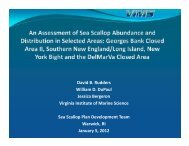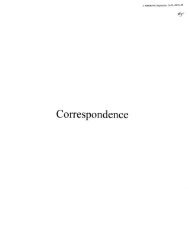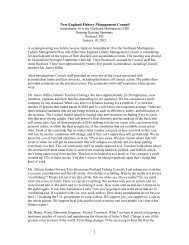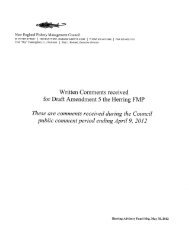Smooth Bottom Net Trawl Fishing Gear Effect on - New England ...
Smooth Bottom Net Trawl Fishing Gear Effect on - New England ...
Smooth Bottom Net Trawl Fishing Gear Effect on - New England ...
Create successful ePaper yourself
Turn your PDF publications into a flip-book with our unique Google optimized e-Paper software.
NOAA/NMFS Unallied Science Project, Cooperative Agreement NA16FL2264 December 2005<br />
<str<strong>on</strong>g>Smooth</str<strong>on</strong>g> <str<strong>on</strong>g>Bottom</str<strong>on</strong>g> <str<strong>on</strong>g>Net</str<strong>on</strong>g> <str<strong>on</strong>g>Trawl</str<strong>on</strong>g> <str<strong>on</strong>g>Fishing</str<strong>on</strong>g> <str<strong>on</strong>g>Gear</str<strong>on</strong>g> <str<strong>on</strong>g>Effect</str<strong>on</strong>g> <strong>on</strong> the Seabed:<br />
Investigati<strong>on</strong> of Temporal and Cumulative <str<strong>on</strong>g>Effect</str<strong>on</strong>g>s BKAM/CR<br />
3.3 Video Sled Results<br />
Visual observati<strong>on</strong>s and side-scan data (Secti<strong>on</strong> 3.2.2) indicate that the seafloors at Mud Hole<br />
and Little Tow represent quite different habitats. These observati<strong>on</strong>s were originally made in<br />
2001 and were again c<strong>on</strong>firmed during the 2002 study. The seafloor at Mud Hole c<strong>on</strong>sists of<br />
fine-grained sediments that form hard, flat mud in the northern regi<strong>on</strong> (Plates 3.3-1 and 3.3-2)<br />
and gradually grade into hummocky flocculent mud in the southern regi<strong>on</strong> (Plates 3.3-3, 3.3-4,<br />
3.3-5, and 3.3-6). Much of the surface of the seafloor in Mud Hole appears to be structured by<br />
biological forces, as evidence are numerous microtopographic features such as tubes, feeding<br />
depressi<strong>on</strong>s, mounds, and tracks and trails. In c<strong>on</strong>trast, much of the seafloor at Little Tow<br />
appears to be structured by physical forces. At Little Tow the seafloor is muddy <strong>on</strong>ly in the<br />
northern regi<strong>on</strong> (Plates 3.3-7 and 3.3-8) and grades into rippled sand and well-defined sand<br />
waves in the southern regi<strong>on</strong> (Plates 3.3-9, 3.3-10, 3.3-11 and 3.3-12). The sandier regi<strong>on</strong>s<br />
evidence much less infaunally produced microtopography, such as tubes, feeding depressi<strong>on</strong>s<br />
and mounds. Additi<strong>on</strong>ally, shell material tends to be more abundant in Little Tow. Within-regi<strong>on</strong><br />
habitat variability (patchiness) also appears to be much more pr<strong>on</strong>ounced in Little Tow.<br />
Several interesting phenomena were observed in the video. Side-scan data had indicated largescale<br />
changes in the sea floor of Little Tow following a str<strong>on</strong>g northeastern storm in middle<br />
November. Basically, the sea floor in the entire southern regi<strong>on</strong> of Little Tow was changed into<br />
large expanses of very uniform sand ripples. These ripples were very visible <strong>on</strong> the video (Plate<br />
3.3-13). Additi<strong>on</strong>ally, while trawl marks were very evident <strong>on</strong> the video footage collected in<br />
2001, this was not the case in 2002. Very few instances of seafloor disturbance by fishing gear<br />
was noted in 2002. This may well have been an artifact of the excepti<strong>on</strong>ally poor visibility that<br />
was encountered in 2002. In 2001, trawl marks were the most evident in the ROV footage which<br />
approached the lanes perpendicular to the directi<strong>on</strong> of tow. While the 2002 video-sled drifts also<br />
approached the lanes perpendicular to the directi<strong>on</strong> of tow, the camera needed to be kept right <strong>on</strong><br />
the bottom, which substantially hampered the depth of field and shadowing necessary to discern<br />
seafloor structure.<br />
3.3.1 General Faunal Patterns<br />
Seven identifiable species categories of fish were observed <strong>on</strong> the video-sled footage. Some<br />
representative species are shown <strong>on</strong> Plate 3.3-14. A total of 432 fish were seen, 278 in Mud Hole<br />
and 154 in Little Tow (Table 3.3-1- raw video sled counts). The most abundant of these were red<br />
hake (185 individuals), flounder (121 individuals), silver hake (33 individuals), sculpin (32<br />
individuals), and ocean pout (24 individuals). Additi<strong>on</strong>ally, two skates, <strong>on</strong>e sea robin, and 34<br />
unidentified fish were also seen. Some differences in the compositi<strong>on</strong> of the fish fauna were<br />
noted between the two study areas. Red hake totally dominated the fish in Mud Hole, accounting<br />
for 50% of the fish seen, but <strong>on</strong>ly accounted for 29.8% of the fish seen in Little Tow. Flounder<br />
were present in roughly equal proporti<strong>on</strong>s, accounting for 27.7% and 28.5% of the fish seen at<br />
Mud Hole and Little Tow, respectively. Sculpin and silver hake accounted for a greater porti<strong>on</strong><br />
of the fish seen in Little Tow (14.9% and 10.4%, respectively) than in Mud Hole (3.3% and<br />
6.1%, respectively).<br />
39







